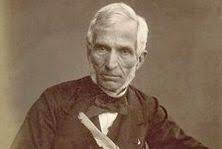
Photographers
Antoine Claudet
1797 — 1867
Antoine Claudet was a French businessman who moved to London to open a glass warehouse. The daguerreotype process quickly attracted his interest and he returned to Paris to be taught its fundamentals by the creator himself, Louis-Jacques Daguerre.
Returning to England with an operating license, he focused on creating and selling daguerreotypes. He was able to speed up the daguerreotype exposure process, which led to his patent recommending using red light and flat, painted backgrounds in darkrooms. In 1842 he focussed on stereoscopic photography - the production of the illusion of depth. He was able to greatly reduce the sitting time for portrait photography. In 1848 he produced the photographometer, an instrument designed to measure the intensity of photogenic rays. In 1849 he brought out the focimeter for securing a perfect focus. In the 1850s he moved on to the calotype and wet-collodion process.
In 1851 he opened his "Temple to Photography' where it is estimated he made 1,800 pictures every year. He composed more than 40 papers documenting his scientific research, which expanded to include stereoscopes. In 1855 he was issued a patent for a large stereoscope which could rotate up to 100 slides. This was a first step in the eventual screen projection of motion pictures.
Shortly after he died in 1867, a fire swept through his Temple To Photography destroying nearly 20,000 prints, negatives, daguerreotypes and his methodology papers.
His manipulation and use of silver in his developments were destroyed.
Last Updated on: 2024-02-28
